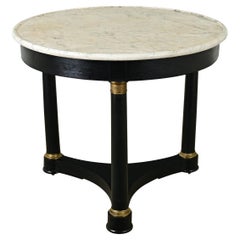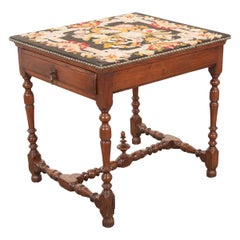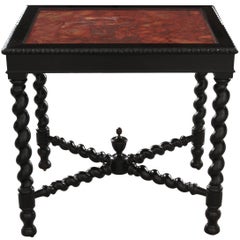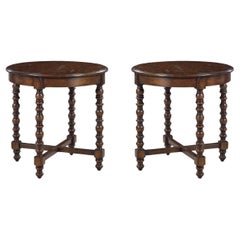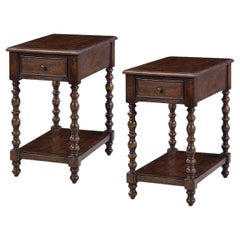Fireside Antiques End Tables
to
Height
to
Width
to
Depth
to
3
3
1
1
2
3
1
1
1
1
3
1
1
1
1
3
3
3
French Ebonized Empire Gueridon
Located in Baton Rouge, LA
Classic, French Empire round end table of white marble top on a tripod base with recent painted finish. The mottled stone top is mostly white with faint gray veining and offers a rai...
Category
Antique 19th Century French Empire End Tables
Materials
Marble, Brass
English 18th Century Jacobean-Style Oak Side Table
Located in Baton Rouge, LA
This stunning English 18th century Jacobean-Style oak trestled side table, circa 1780s, and features a surface covered with a beautiful needlepoint tapestry, in shades of red and gol...
Category
Antique Late 18th Century English Jacobean End Tables
Materials
Oak
Italian 19th Century Ebony Table with Scagliola Top
Located in Baton Rouge, LA
A striking Italian ebony table, made in the 19th century, with an inset top of rust-colored Scagliola stone. The table top is trimmed in a mirrored...
Category
Antique 19th Century Italian Tables
Materials
Hardwood, Scagliola
Related Items
Pair of Jacobean Round Side Tables
Located in Westwood, NJ
A Jacobean style round side table with an ogee top edge, in our distressed rustic country wood tone with natural highlights, with a hand rubbed satin finish.
Dimensions: 24" W x 2...
Category
21st Century and Contemporary Vietnamese Jacobean Side Tables
Materials
Wood
Pair of Jacobean Style Side Tables
Located in Westwood, NJ
A Jacobean style rectangular one-drawer side table with an ogee top edge, in our distressed rustic country wood tone with natural highlights, with a hand-rubbed satin finish with a b...
Category
21st Century and Contemporary Vietnamese Jacobean End Tables
Materials
Wood
19th Century English Oak Side Table
Located in High Point, NC
19th Century oak side table from England in a William & Mary style. The top is made from two boards, following down to simple sides with scalloping and a single drawer in the front w...
Category
Antique 19th Century English Victorian Side Tables
Materials
Oak
French Empire Style Mahogany Table with Marble Top, 19th Century
Located in El Monte, CA
A handsome Empire style mahogany center table with a black marble top circa 1840. Surrounding the edge of the tabletop is a brass gallery with an openwork design. A rich mahogany fri...
Category
Antique 19th Century French Empire End Tables
Materials
Marble, Brass
English Jacobean Rectangular Oak Side Table
Located in Queens, NY
English Jacobean (17th Century) rectangular rustic oak table with 3-plank overhanging top, incised legs with a box sretcher and a fine finish enhancing the grain.
Dark circular mark...
Category
Antique 17th Century British Jacobean Side Tables
Materials
Oak
18th Century English Oak Side Table
Located in High Point, NC
18th century oak side table from England with a two board top, surrounded by a beveled and hand carved decorated edge. The top follows down to a gorgeous hand carved decorated apron,...
Category
Antique Mid-18th Century English George II Side Tables
Materials
Oak
19th Century English Jacobean End Table
Located in Dallas, TX
19th Century English Jacobean End Table was hand-crafted by able artisans from indigenous old-growth oak, and features a solid plank top supported by solid plank aprons connected on each corner with the top of four beautifully turned legs. It would be fascinating to see how the legs were turned using tools...
Category
Antique 1870s English Jacobean End Tables
Materials
Oak
18th Century English Oak Side Table
Located in High Point, NC
18th century Oak side table from England with a two plank top, which has a beveled edge, following down to simple sides and a single drawer in the front. The drawer has a molded edge...
Category
Antique 18th Century English Georgian Side Tables
Materials
Oak
18th Century French Walnut Side Table
Located in High Point, NC
Mid-18th-century walnut side table from France with banded ends on the top, over wonderfully hand scalloped aprons on three sides and a single drawer in the front. The table is finis...
Category
Antique Mid-18th Century French Side Tables
Materials
Walnut
18th Century English Side Table
Located in High Point, NC
18th Century English side table made from oak with a beveled edge around the top, following down to a simple apron with a single drawer in the front. The legs are hand turned and ha...
Category
Antique 18th Century English George III Side Tables
Materials
Brass
19th Century Table with Marble Top
Located in Houston, TX
19th century beech gueridon with 3 legs on wheels. Legs are detailed with black lacquer at the top and at the base of each column.
Category
Antique 1880s French Empire Side Tables
Materials
Belgian Black Marble
19th Century English Bamboo Side Table
Located in Staffordshire, GB
19th century English bamboo side table,
circa 1875.
Measures: W 57 x D 55.5 x H 72
Category
Antique Late 19th Century British Side Tables
Materials
Bamboo
